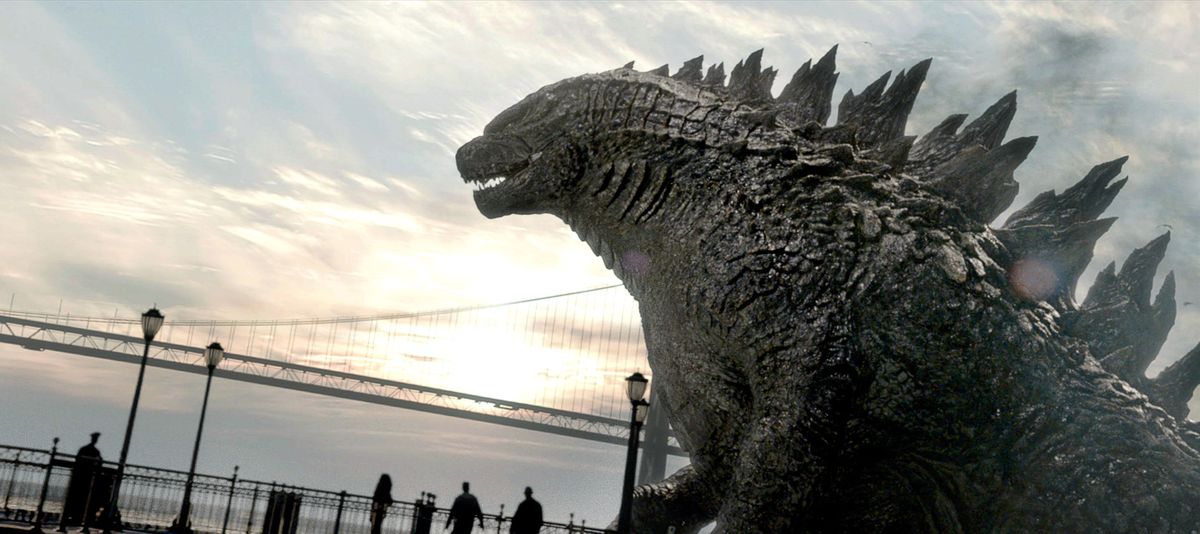‘Godzilla’ remake steps into big footprints

“I’m always trying to get a bit of ‘Apocalypse Now’ into anything I do,” said Edwards back in January, when the soft-spoken Brit was still in the throes of completing his Hollywood debut.
But it wasn’t a conventional war movie Edwards was crafting; rather, it was another new take on “Godzilla.”
Due in theaters Friday, Edwards’ “Godzilla” reboot might not necessarily inspire comparisons to Francis Ford Coppola’s meditative epic, but there’s no question the would-be blockbuster has apocalyptic concerns in mind. The $160-million film, which stars Aaron Taylor-Johnson, Elizabeth Olsen and Bryan Cranston, draws inspiration from Ishiro Honda’s original 1954 classic, presenting a sober, dramatic take on the King of All Monsters.
Amid the creature feature trappings, Edwards presents a cautionary tale about environmental collapse and the dangers of nuclear energy.
An early flashback to a reactor meltdown in Japan recalls the 2011 Fukushima Daiichi disaster that devastated the east coast of Japan – which the director admits could surprise audiences expecting pure summer movie bombast.
“Our film doesn’t preach,” said Edwards, 38. “But we tried to respectfully show that we opened a Pandora’s box when we started doing all this stuff. Obviously our monsters are metaphors, and they’re never going to really appear, but (the film points out that) we should be very careful in terms of this amazing power of nature that we’re trying to control. The reality is, we can’t always contain it.”
Written by Max Borenstein with a story by Dave Callaham, “Godzilla” pits its 355-foot-tall title character against a new monster, the M.U.T.O., which stands for Massive Unidentified Terrestrial Organism. Cranston’s scientist, Joe Brody, and his son, Ford, played as an adult by Taylor-Johnson (“Kick-Ass,” “Nowhere Boy,” “Anna Karenina”), accidentally learn about the M.U.T.O. after Joe leads them into a quarantined area of Japan and plunges them into danger.
Soon, Ford, an explosive-ordnance disposal expert just back from a tour of duty in the Middle East, must put his naval skills to use to make it back to San Francisco and his wife, Elle (Olsen), and their young son as giant monsters rain down destruction across the globe.
The ensemble cast also includes Juliette Binoche, David Straithairn and Sally Hawkins and Ken Watanabe as researchers with a personal connection to the marauding M.U.T.O.
“Godzilla” arrives as Edwards’ second film; his first, 2010’s “Monsters,” he wrote and directed himself and paid for partly with his own savings. But he aspired to give the big-budget movie the same poignancy as the crowd-pleasing sci-fi cinema that initially inspired him, the late 1970s and early 1980s films directed by George Lucas, Steven Spielberg and James Cameron.
“When you look at a film, there’s certain key emotions you’re going to provoke and feelings you’re going to try to create for the audience,” Edwards said in a separate interview at the end of April. “I’m always looking for where’s the bit where they might tear up – even if it’s not tearing up in a sad way, just that you’re so much in awe of what you’re looking at that you get goose bumps and you start to well up. ‘Close Encounters (of the Third Kind)’ does that for me.”
When Godzilla rose out of the ashes of Hiroshima and Nagasaki, the creature struck a deep, emotional chord with a ravaged nation decimated by the atomic blasts that ended World War II. The film, which saw the radioactive dinosaur-like beast emerge from the ocean to demolish Tokyo, astutely used genre to address the horrors of war and connected with a traumatized, wounded people.
The most expensive movie Japan had then made, “Godzilla” elevated the profile of production company Toho to international acclaim – though on the occasion of its U.S. release in 1956, the film famously was dubbed into English and new scenes with actor Raymond Burr were added to help “Godzilla, King of the Monsters!” appeal to American audiences.
In all, Godzilla – or Gojira, as he was originally known – has starred in 28 live-action feature films, many of them gleeful B-movies that pitted the giant lizard against some equally enormous foe (usually actors wearing rubber costumes) with such titles as “Son of Godzilla,” “Godzilla Versus the Sea Monster,” “Godzilla vs. the Smog Monster” and “Mothra vs. Godzilla.”
Although he’s remained a fixture in video games, comic books and other avenues of popular culture, Godzilla has had a mixed track record at the box office of late.
Roland Emmerich failed to launch a new “Godzilla” franchise for the CGI era with his critically drubbed 1998 film – though that movie, which brought the monster to Manhattan, did earn $379 million at the worldwide box office.
The character most recently anchored “Godzilla 2000,” directed by Takao Okawara, in which he saved Tokyo from an evil kaiju that arrives in a UFO.